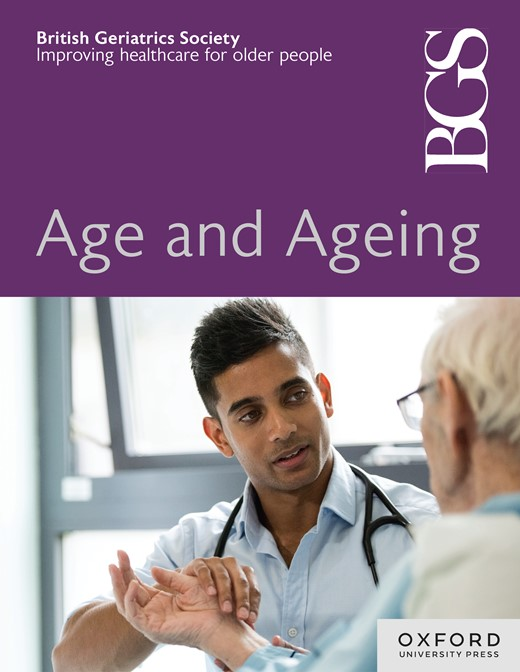抗胆碱能认知负担的变化与单次和复发性跌倒的风险:基于人群的队列研究
IF 6
2区 医学
Q1 GERIATRICS & GERONTOLOGY
引用次数: 0
摘要
背景:高抗胆碱能认知负荷(ACB)药物与老年人跌倒风险增加有关。然而,随着时间的推移,ACB变化对风险的潜在影响尚未确定。目的探讨单次跌倒和反复跌倒与ACB变化的关系。方法采用欧洲癌症-诺福克调查(EPIC-Norfolk)研究参与者的数据,年龄在40岁及以上,参加了第一次(1HC: 1993-98)、第二次(2HC: 1998-2000)和第三次(3HC: 2004-11)健康检查。主要结局是在3HC时间点之前的12个月内发生单一跌倒事件或复发性跌倒($ $ 2$)。结果纳入了10717名参与者的数据,中位年龄为55.6(13.1)岁。3,445名(32.2%)参与者在基线时ACB为1或更高。参与者分为四组:无(67.8%)、晚期(21.1%)、短暂(6.8%)和持续(4.3%)。晚期暴露(OR 1.49, 95% CI 1.25-1.79)、短暂暴露(1.66,1.28-2.14)和连续暴露(1.67,1.22-2.29)与未暴露相比,复发性跌倒增加显著相关。中介分析显示,步态速度(GS)导致了与ACB相关的复发性跌倒风险增加的16.9% (CI: 9.4%-27.8%)。在14年的随访中,40岁及以上的成年人使用抗胆碱能药物与复发性跌倒有关,无论在随访期间是否开始或停止使用。未来的研究应该确定有效的策略,在开始使用抗胆碱能药物时,将跌倒的长期风险降到最低,其中可能包括GS作为风险检测和监测工具。本文章由计算机程序翻译,如有差异,请以英文原文为准。
Changes in anticholinergic cognitive burden and risk of single and recurrent falls: population-based cohort study
Background Medications with high anticholinergic cognitive burden (ACB) are associated with increased fall risk in older adults. However, the potential alteration of risk with changes in ACB over time has yet to be established. Objective To estimate the association between the changes in ACB with single and recurrent falls. Methods Data from European Investigation of Cancer-Norfolk (EPIC-Norfolk) study participants, aged 40 years and above, who attended the first (1HC:1993–98), second (2HC:1998–2000) and third (3HC: 2004–11) health checks were utilised. The main outcome was a single fall event or recurrent ($\ge 2$) falls occurring during the 12 months preceding the time point of the 3HC. Results Data from 10 717 participants with a median, Interquartile range (IQR) age of 55.6 (13.1) years were included. Three thousand four hundred forty-five (32.2%) participants had an ACB of one or greater at baseline. Participants were classified into four groups: no (67.8%), late (21.1%), transient (6.8%) and continuous (4.3%). Late (OR 1.49, 95% CI 1.25–1.79), transient (1.66, 1.28–2.14) and continuous (1.67, 1.22–2.29) exposure were significantly associated with increased recurrent falls compared with no exposure. Mediation analysis revealed that gait speed (GS) contributed to 16.9% (CI: 9.4%–27.8%) of the increase in risk of recurrent falls associated with ACB. Discussion Anticholinergic medication use, in adults aged 40 years and above, was linked to recurrent falls at 14-year follow-up, regardless of whether introduction or cessation occurred during the follow-up. Future research should determine effective strategies for minimising the long-term risk of falls when starting anticholinergic medications, which could include GS as a risk-detection and monitoring tool.
求助全文
通过发布文献求助,成功后即可免费获取论文全文。
去求助
来源期刊

Age and ageing
医学-老年医学
CiteScore
9.20
自引率
6.00%
发文量
796
审稿时长
4-8 weeks
期刊介绍:
Age and Ageing is an international journal publishing refereed original articles and commissioned reviews on geriatric medicine and gerontology. Its range includes research on ageing and clinical, epidemiological, and psychological aspects of later life.
 求助内容:
求助内容: 应助结果提醒方式:
应助结果提醒方式:


